The 1936 Ford Sedan Delivery, a sturdy and versatile vehicle, embodies the spirit of innovation and resilience that characterized the American automotive industry during the Great Depression. This iconic delivery truck, a testament to Ford’s enduring legacy, played a pivotal role in shaping the economic landscape of the era, serving as a reliable workhorse for businesses and individuals alike.
Its distinctive design, with its streamlined body and signature Ford grille, captured the essence of the era’s aesthetic. The Sedan Delivery offered a practical and affordable solution for transportation needs, contributing to the resurgence of the American economy in the wake of the Depression.
Its robust construction and efficient performance made it a favorite among businesses, while its versatility allowed for a wide range of applications, from delivering goods to transporting people.
Historical Context

The 1936 Ford Sedan Delivery was produced during a tumultuous period in American history. The country was still grappling with the devastating effects of the Great Depression, which had begun in 1929. The economic downturn had led to widespread unemployment, poverty, and social unrest.
Social and Economic Conditions in the United States in 1936
The year 1936 saw a slight improvement in the American economy, but the Great Depression was far from over. The unemployment rate remained high, at 16.9%. The Dust Bowl, a period of severe dust storms that ravaged the Great Plains, had a significant impact on agriculture and the lives of many Americans.
Despite the economic challenges, President Franklin D. Roosevelt’s New Deal programs were starting to show signs of success. These programs aimed to provide relief to the unemployed, stimulate the economy, and reform the financial system.
The Role of the Automobile Industry in the American Economy
The automobile industry played a crucial role in the American economy during the 1930s. The industry was a major employer, and its success was closely tied to the overall health of the economy. However, the Great Depression had a significant impact on the auto industry.
Car sales plummeted, and many automakers struggled to stay afloat.
The Impact of the Great Depression on Ford Motor Company
Ford Motor Company, one of the largest automakers in the world, was not immune to the effects of the Great Depression. The company’s sales dropped dramatically, and it was forced to lay off thousands of workers. Ford’s founder, Henry Ford, initially resisted government intervention and refused to participate in New Deal programs.
The 1936 Ford Sedan Delivery, with its boxy design and utilitarian purpose, was a far cry from the sleek, performance-driven machines that would come to define Ford’s legacy. However, it’s interesting to consider the evolution of the brand through models like the 1965 Ford Mustang Shelby GT350 , a car that epitomized American muscle and racing spirit.
While the Sedan Delivery served as a workhorse, the GT350 exemplified the thrill of the open road, highlighting Ford’s ability to adapt and innovate across generations.
However, the company eventually accepted government assistance and began to recover.
Design and Features
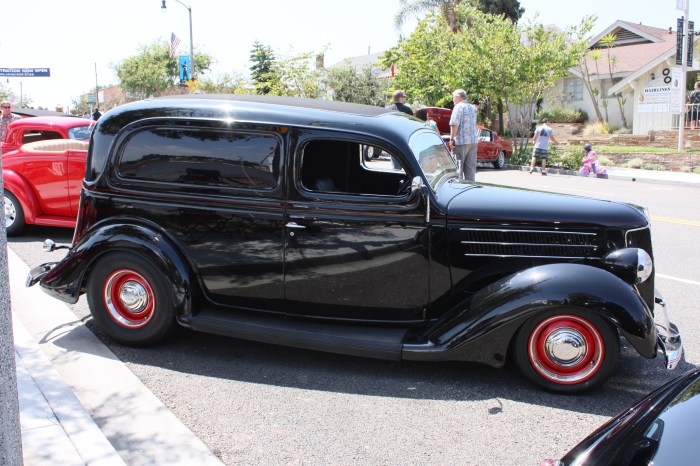
The 1936 Ford Sedan Delivery was a practical and stylish vehicle designed to meet the needs of businesses and individuals alike. It built upon the design of the standard Ford Sedan, incorporating key features that made it a versatile workhorse.The Sedan Delivery was distinguished by its closed-body design, which provided a secure and weather-resistant cargo area.
This was a significant departure from the open-bed trucks of the time, offering greater protection for goods and passengers.
Technical Specifications
The 1936 Ford Sedan Delivery was powered by a 221 cubic inch (3.6 liter) V8 engine, generating 85 horsepower. This engine was mated to a three-speed manual transmission, providing a reliable and efficient driving experience. The Sedan Delivery featured a sturdy chassis and suspension system, capable of handling a payload of up to 1,500 pounds.
The 1936 Ford Sedan Delivery, with its distinctive boxy body and practicality, was a popular choice for businesses and individuals alike. Its predecessor, the 1929 Ford 2-Dr Sedan , was known for its elegance and affordability, showcasing a shift in Ford’s design philosophy.
While the 1929 model prioritized style, the 1936 Sedan Delivery emphasized utility, reflecting the changing needs of the time.
The 1936 Ford Sedan Delivery offered a powerful and reliable engine, coupled with a robust chassis, making it a capable workhorse.
Production and Sales
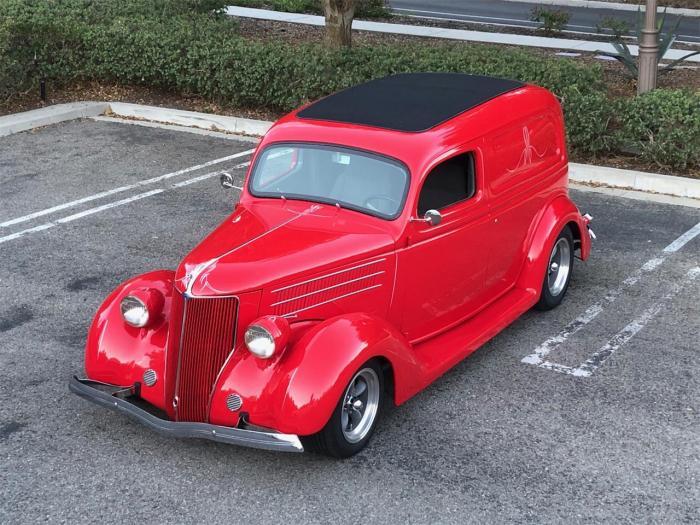
The 1936 Ford Sedan Delivery, like other vehicles from the era, was a product of its time, reflecting both the economic realities and the evolving automotive landscape of the 1930s. Understanding its production and sales figures, as well as the target market and marketing strategies employed, provides valuable insights into its place in automotive history.
Production and Sales Figures
Ford produced a significant number of 1936 Sedan Deliveries, reflecting the model’s popularity and its role in meeting the diverse transportation needs of the time. However, precise production figures for the Sedan Delivery are not readily available, making it difficult to provide an exact number.
This is common for older vehicles, especially those produced before comprehensive tracking systems became standard. Nevertheless, it’s important to recognize that the Sedan Delivery was a key part of Ford’s product lineup, contributing to the company’s overall success during this period.
Target Market
The 1936 Ford Sedan Delivery was designed to appeal to a broad target market, encompassing businesses and individuals with varying needs. This vehicle was particularly well-suited for:
- Small businesses and entrepreneurs: The Sedan Delivery’s enclosed cargo area provided a secure and practical solution for transporting goods, making it ideal for businesses like bakeries, florists, and delivery services.
- Farmers and ranchers: The vehicle’s durability and cargo capacity made it suitable for transporting agricultural products, livestock, and supplies.
- Individuals seeking versatile transportation: The Sedan Delivery’s combination of passenger and cargo space made it a practical choice for families or individuals needing to transport both people and goods.
Marketing Strategies
Ford employed various marketing strategies to promote the 1936 Sedan Delivery, emphasizing its versatility and practicality. These strategies included:
- Targeted advertising: Ford placed advertisements in publications catering to specific target markets, such as business journals and agricultural magazines. These ads highlighted the Sedan Delivery’s features and benefits tailored to each audience.
- Demonstrations and test drives: Ford dealerships organized demonstrations and test drives to showcase the Sedan Delivery’s capabilities, allowing potential buyers to experience its versatility firsthand.
- Promotional campaigns: Ford launched promotional campaigns featuring the Sedan Delivery, often highlighting its use in various industries and applications. These campaigns helped raise awareness and generate interest in the vehicle.
Usage and Applications

The 1936 Ford Sedan Delivery was a versatile vehicle designed to meet the diverse needs of both businesses and individuals. Its spacious cargo area and robust construction made it an ideal choice for a wide range of applications.
Commercial Applications
The Sedan Delivery was a popular choice for businesses across various industries. Its large cargo capacity allowed for efficient transportation of goods, while its reliability and durability ensured long-lasting service.
- Delivery Services:The Sedan Delivery was a staple for delivery companies, transporting everything from groceries and packages to furniture and appliances. Its compact size made it maneuverable in urban areas, while its sturdy construction could handle heavy loads.
- Retail Businesses:Retailers used the Sedan Delivery to transport merchandise, deliver orders, and even as mobile showrooms. Its versatility allowed businesses to reach customers in different locations, expanding their reach and customer base.
- Construction and Trades:Contractors and tradespeople relied on the Sedan Delivery for hauling tools, materials, and equipment. Its durability and cargo space made it a reliable workhorse for construction sites and service calls.
- Agriculture:Farmers and ranchers used the Sedan Delivery for transporting produce, livestock, and supplies. Its rugged construction and spacious cargo area made it suitable for handling the demands of agricultural work.
Personal Applications
Beyond its commercial uses, the Sedan Delivery also found its way into the lives of individuals. Its spacious interior and versatility made it a practical and affordable choice for personal transportation and leisure activities.
The 1936 Ford Sedan Delivery, a classic workhorse of its time, was a far cry from the muscle car era of the late 1960s. While the 1936 model was built for utility and durability, the 1969 Ford Fairlane represented a shift towards performance and style.
The 1936 Sedan Delivery, however, remains a symbol of American ingenuity and the evolution of automotive design.
- Family Transportation:Families used the Sedan Delivery for transporting children, groceries, and luggage. Its spacious interior provided ample room for passengers and cargo, making it a practical choice for everyday use.
- Recreational Activities:The Sedan Delivery was also used for camping, fishing, and other outdoor activities. Its spacious cargo area could accommodate camping gear, fishing equipment, and other recreational supplies.
- Customized Applications:Some individuals customized their Sedan Deliveries for specific purposes. This included converting them into mobile workshops, mobile kitchens, or even ambulances.
Impact on American Society and Culture
The 1936 Ford Sedan Delivery played a significant role in shaping American society and culture. Its affordability and versatility made it accessible to a wide range of individuals and businesses, contributing to the growth of the American economy and the development of a mobile society.
- Economic Growth:The Sedan Delivery’s widespread use boosted the American economy by creating jobs in manufacturing, transportation, and related industries.
- Mobility and Convenience:The Sedan Delivery provided Americans with greater mobility and convenience, allowing them to travel further and faster, expanding their horizons and opportunities.
- Cultural Influence:The Sedan Delivery became a symbol of American ingenuity and innovation, representing the spirit of hard work and entrepreneurialism that defined the era.
Legacy and Significance
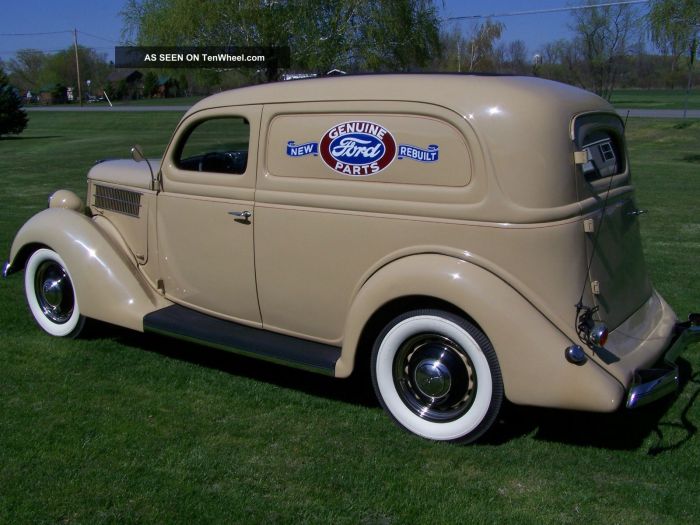
The 1936 Ford Sedan Delivery, a product of the Depression era, stands as a testament to Ford’s innovative spirit and its impact on the evolving landscape of the automotive industry. Its design, practicality, and affordability left a lasting mark, influencing the development of commercial vehicles for decades to come.
The 1936 Ford Sedan Delivery’s Impact on the Automobile Industry
The 1936 Ford Sedan Delivery played a pivotal role in shaping the commercial vehicle segment. Its introduction marked a significant departure from traditional delivery trucks, offering a more versatile and affordable option for businesses. Its enclosed body, which provided protection for goods and passengers, revolutionized the way businesses transported their wares.
This design concept became a standard in the industry, inspiring countless subsequent models.The Sedan Delivery’s success was driven by its affordability, making it accessible to a wider range of businesses. This accessibility spurred the growth of the commercial vehicle market, leading to increased demand for similar vehicles and encouraging other manufacturers to enter the segment.
This competition further fueled innovation, leading to the development of more sophisticated and specialized commercial vehicles.The Sedan Delivery’s influence extended beyond its direct impact on the commercial vehicle market. Its design and features, such as its enclosed body and passenger seating, inspired the development of station wagons and other multi-purpose vehicles.
These vehicles, in turn, broadened the appeal of automobiles beyond mere transportation, leading to their adoption for leisure and family use.
Comparison with Other Similar Vehicles of the Era, 1936 Ford Sedan Delivery
The 1936 Ford Sedan Delivery stood out from its contemporaries by offering a combination of affordability, practicality, and style. While other manufacturers offered similar vehicles, they often lacked the versatility and affordability of the Ford model.
- The Chevrolet Sedan Delivery, a direct competitor, was known for its ruggedness but was generally more expensive than the Ford. The Chevrolet lacked the sleek design and passenger seating that made the Ford Sedan Delivery a more appealing option for businesses.
- The Dodge Sedan Delivery was another competitor, offering a similar enclosed body and passenger seating. However, the Dodge model was less fuel-efficient and had a less refined design than the Ford, making it less desirable for businesses seeking a balance of practicality and style.
- The International Harvester Sedan Delivery was a more utilitarian vehicle, focused on durability and cargo capacity. While it was a reliable option for heavy-duty applications, it lacked the passenger seating and aesthetic appeal of the Ford Sedan Delivery.
The 1936 Ford Sedan Delivery’s success can be attributed to its unique combination of features, including its affordable price, practical design, and passenger seating. These factors made it a versatile and appealing option for a wide range of businesses, solidifying its position as a leading commercial vehicle of the era.
Visual Representation: 1936 Ford Sedan Delivery
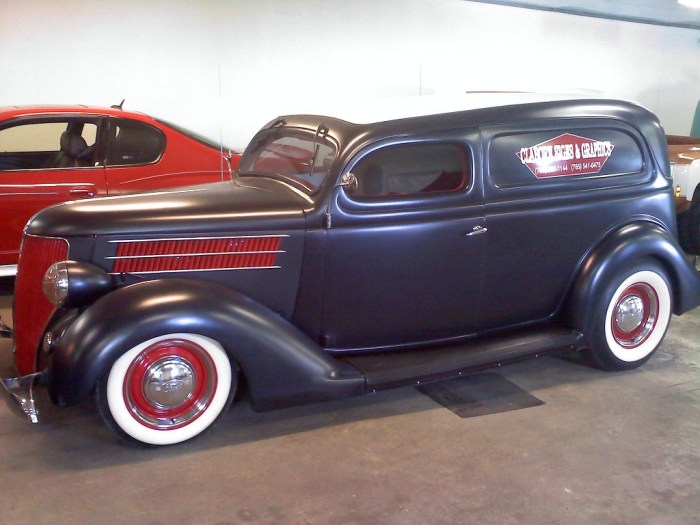
The 1936 Ford Sedan Delivery, a versatile vehicle designed for both commercial and personal use, possessed a distinctive appearance that reflected the era’s evolving automotive design trends. Its exterior and interior features showcased a blend of practicality and style, reflecting the evolving needs of a rapidly changing society.
Exterior Design
The 1936 Ford Sedan Delivery’s exterior design was characterized by its streamlined body, a feature that was becoming increasingly popular in the automotive industry at the time. The vehicle’s front end featured a prominent grille with horizontal bars, a rounded hood, and integrated headlights.
The body was smooth and rounded, with a distinct sloping roofline that contributed to its aerodynamic profile. The rear of the vehicle featured a large, single door that provided access to the cargo area. This door was typically equipped with a large, single window that allowed for visibility into the cargo space.
Interior Design
The interior of the 1936 Ford Sedan Delivery was designed with practicality in mind. The cabin featured a simple dashboard with basic instrumentation, including a speedometer, fuel gauge, and temperature gauge. The seating was typically bench-style, providing room for two passengers in the front.
The interior was often finished with durable materials such as vinyl or cloth, which were designed to withstand the rigors of commercial use.
Key Design Features and Specifications
The table below provides a summary of the key design features and specifications of the 1936 Ford Sedan Delivery:| Feature | Description ||—|—|| Body Style | Sedan Delivery || Engine | 221 cubic inch (3.6 L) Flathead V8 || Horsepower | 60 hp (45 kW) || Transmission | Three-speed manual || Wheelbase | 112 inches (2,845 mm) || Length | 169.5 inches (4,306 mm) || Width | 66 inches (1,676 mm) || Height | 66 inches (1,676 mm) || Curb Weight | 2,500 lbs (1,134 kg) |
Visual Representation of the 1936 Ford Sedan Delivery in Use
The 1936 Ford Sedan Delivery was a versatile vehicle that found application in a wide range of industries. The vehicle’s spacious cargo area made it ideal for transporting goods, while its sturdy construction ensured durability. A typical visual representation of the 1936 Ford Sedan Delivery in use would depict the vehicle carrying a variety of goods, such as groceries, furniture, or building materials.
The vehicle would often be seen on city streets, delivering goods to businesses and homes, or on rural roads, transporting agricultural products or supplies.
Ending Remarks
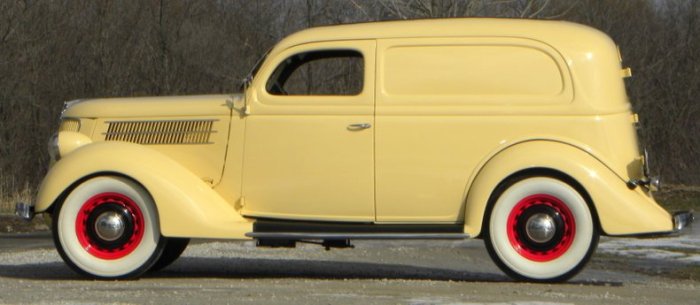
The 1936 Ford Sedan Delivery stands as a testament to the ingenuity and adaptability of the American automotive industry during a challenging period. Its enduring legacy is reflected in its continued presence on roads today, a reminder of its significant contribution to American culture and economic growth.
This classic vehicle continues to inspire enthusiasts and collectors, serving as a tangible connection to a bygone era.